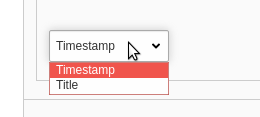FlexForm definitions
FlexForms are defined as XML with a syntax similar to TCA.
Defining fields in a FlexForm
The definition of data types and parameters complies with the column types defined by TCA.
The settings must be added inside the
<el> element in the FlexForm
configuration schema file.
Select field
<settings.orderBy>
<label>
LLL:EXT:example/Resources/Private/Language/Backend.xlf:settings.registration.orderBy
</label>
<config>
<type>select</type>
<renderType>selectSingle</renderType>
<items>
<numIndex index="0">
<label>
LLL:EXT:example/Resources/Private/Language/Backend.xlf:settings.registration.orderBy.crdate
</label>
<value>crdate</value>
</numIndex>
<numIndex index="1">
<label>
LLL:EXT:example/Resources/Private/Language/Backend.xlf:settings.registration.orderBy.title
</label>
<value>title</value>
</numIndex>
</items>
</config>
</settings.orderBy>See also
- Select fields in TCA reference.
Populate a select field using a PHP Function (itemsProcFunc)
<settings.orderBy>
<label>
LLL:EXT:example/Resources/Private/Language/Backend.xlf:settings.registration.orderBy
</label>
<config>
<type>select</type>
<itemsProcFunc>MyVendor\Example\Backend\ItemsProcFunc->user_orderBy
</itemsProcFunc>
<renderType>selectSingle</renderType>
<items>
<!-- empty by default -->
</items>
</config>
</settings.orderBy>The function
user_ populates the select field in
Backend/:
class ItemsProcFunc
{
/**
* Modifies the select box of orderBy-options.
*
* @param array &$config configuration array
*/
public function user_orderBy(array &$config)
{
// simple and stupid example
// change this to dynamically populate the list!
$config['items'] = [
// label, value
['Timestamp', 'timestamp'],
['Title', 'title']
];
}
// ...
}How this looks when configuring the plugin:

See also
- itemsProcFunc in TCA reference.
Display fields conditionally (displayCond)
Some settings may only make sense in the context of other settings. For example, in one setting you define a sorting order (by date, title etc.) and all sort orders except "title" have additional settings. These are only visible if sort order "title" is not selected.
You can define conditions using displayCond. This defines whether a setting should be displayed when the plugin is configured. It can depend on one or more settings in the FlexForm, on database fields in the current record or be defined by a user function.
<config>
<type>select</type>
</config>
<!-- Hide field if value of neighbour field "settings.orderBy" on same sheet is not "title" -->
<displayCond>FIELD:settings.orderBy:!=:title</displayCond>Again, the syntax and available fields and comparison operators is documented in the TCA reference:
See also
- Display conditions in TCA columns in TCA Reference
Reload on change
When displaying settings using displayCond, you may want to trigger a form reload when some settings are changed. You can do that with:
<onChange>reload</onChange>
<config>
<!-- ... -->
</config>The
on element is optional and must be placed at the same level as
the
<config> element.
Providing default values for FlexForms attributes
When a new content element with a FlexForm is created, the
default value of each FlexForm attribute is fetched from the
<default> XML attribute inside the specification of each
FlexForm attribute. If that is missing, an empty value will be
shown in the backend (FormEngine)
fields.
While can use page TSconfig's TCAdefaults to modify defaults of TCA-based attributes, it is not possible with FlexForms. This is because the values are calculated at an earlier step in the Core workflow, where FlexForm values have not yet been extracted.
